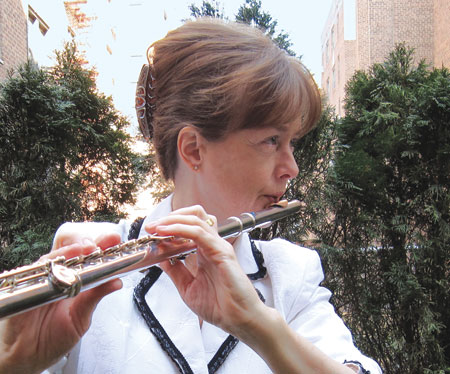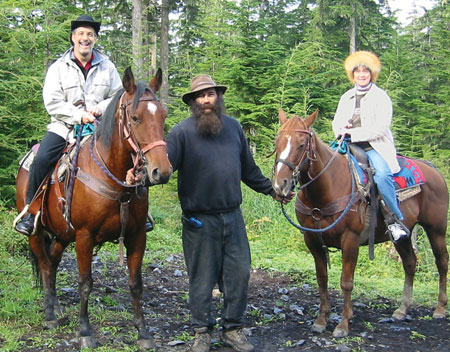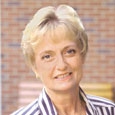 There is a reserve to Jan Vinci – a peaceful quietness that hides her intense curiosity about life in general and music in particular. She has performed at Carnegie Hall, Alice Tully Hall, the Blossom Music Festival, the International Computer Music Conference in The Hague, and many more venues around the world. Her chamber music career spans over 20 years and includes such groups as Iridescence – Flute and Harp Duo with Karlinda Caldicott, Tritonis, an ensemble with guitarist Joel Brown and cellist Ann Alton, and Percussia, an ensemble with percussion.
There is a reserve to Jan Vinci – a peaceful quietness that hides her intense curiosity about life in general and music in particular. She has performed at Carnegie Hall, Alice Tully Hall, the Blossom Music Festival, the International Computer Music Conference in The Hague, and many more venues around the world. Her chamber music career spans over 20 years and includes such groups as Iridescence – Flute and Harp Duo with Karlinda Caldicott, Tritonis, an ensemble with guitarist Joel Brown and cellist Ann Alton, and Percussia, an ensemble with percussion.
Vinci grew up in the shadow of the Great Smokey Mountains in Maryville, Tennessee, an area that had few professional musicians at the time. That didn’t stop the Vinci family, however. They played and sang together on a regular basis. Her father was a doctor, now retired, and her mother was a stay-at-home mom, raising five children. “My Dad plays a mean Boogie Woogie piano and plays piano and harmonica in the Turkeys in the Straw Band; they perform at nursing homes and local functions. My mother loves to sing and often joins them. When I was growing up we often camped and would sing and play the ukulele and dulcimer around the campfire.”
Like many flutists, Vinci chose the flute as a child “because it was so shiny and beautiful. I had no idea how it sounded. Also, band was popular in our area. By the time I graduated from high school I had only heard an orchestra concert once.” The closest town large enough to support an orchestra was Knoxville, and the Knoxville Symphony was a chamber orchestra then and mostly volunteer. Flute teachers were also few and far between, so Vinci learned on her own. “I would tape record myself playing one part of a duet, and then play the other part. That was my chamber music experience growing up, but it was fun. I always had a passion for playing. I didn’t know how to practice or that you were supposed to practice every day, but I loved to play, and did so a fair amount.”
In junior high she began studying with her band director, Charles Hurt, who later became the principal trombonist with the Austin Symphony Orchestra for 30 seasons. He is now the trombone professor at Texas State University. “He played flute duets with me. His musicality was such an inspiration. Luckily, he saw that I needed a flute teacher and arranged an audition with Judith Bentley, who was teaching at the University of Tennessee.
 “She proceeded to give me one of the most comprehensive learning years of my entire life. She taught me all aspects of being a musician from how to play the instrument and interpret the music to how to present myself on stage. I also studied music theory with her husband. They gave me the foundation upon which I base my playing today.”
“She proceeded to give me one of the most comprehensive learning years of my entire life. She taught me all aspects of being a musician from how to play the instrument and interpret the music to how to present myself on stage. I also studied music theory with her husband. They gave me the foundation upon which I base my playing today.”
The Bentleys left Knoxville the next year, so Vinci was once again on her own, but she continued to learn by reading John Krell’s Kincaidiana and listening to recordings, such as William Kincaid’s Award Artist Series and Rampal’s early records of the Bach sonatas. During high school she studied with David Van Vactor, former second flutist with the Chicago Symphony and the new conductor of the Knoxville Symphony.
Her band director was a graduate of the University of Michigan and encouraged her to go there for college. After two years however, Vinci transfered to Bowling Green State University, where Judith Bentley was teaching. “It was a fantastic school. I was in so many ensembles, often rehearsing seven hours a day. Mrs. B, as we called her, pumped me full of information and helped me establish a good foundation of repertoire.”
After graduation, she followed a jazz musician named Mark Vinci to Denton, Texas, where he attended the University of North Texas. She took the opportunity to study with George Morey and also discovered Paula Robison’s playing via recording. “I practically wore out her Romantic Flute record from trying to imitate her so much. She was an important influence on me then, and many years later, I studied with her.
“When Mark went on the road, I went home to Tennessee to regroup, practice a lot, and earn enough money to go back to school. I had played in the Blossom Festival the summer after graduating from Bowling Green, and had fallen in love with the Cleveland Orchestra and Maurice Sharp’s flute playing. The orchestra was so expressive and clear, and I was intrigued by its sound. It was that experience that made me want to learn more from Maurice Sharp. Then I discovered that a former Sharp student, Robin Fellows, was teaching at Tennessee Tech, so I worked with him during that year. He helped me prepare for the entrance audition for The Cleveland Institute.”
Cleveland and Maurice Sharp
.jpg)
Vinci was accepted and studied with Sharp for a year and a half, which she says was “one of the most remarkable experiences I have had. He brought the flute part for the orchestra performances that week to every lesson, and we would go over the music. I also made it a point to hear two Cleveland Orchestra concerts a week, serving as an usher.
“I fell in love with the orchestral repertoire and with the idea of a musical community of people who work together. I know that many large organizations, whether musical or otherwise, have internal problems, but I really got a sense that the orchestra members respected what their former conductor George Szell had built and what they wanted to continue to be in the future. Their sense of pride was not so much egotistical, as it was respect for the ensemble.
“It also struck me that the Cleveland Orchestra knew how to play like a chamber ensemble. Although my passion has never been to play in an orchestra, I learned so much from them that I was able to transfer into my field of chamber music.”
“One of my favorite Maurice Sharp stories is two-tiered. As usual, one week he brought in the flute part for the piece that the orchestra was performing, which happened to be a new piece by Luciano Berio. Singers were interspersed throughout the orchestra, and a soprano was positioned right behind the first flute chair. In my lesson he was quite noticeably upset about the piece and the position of the singer and said that Berio did not know how to write for the flute. He proceeded to play a fast arpeggiated passage that went from the bottom of the flute to the top, with several peaks along the way. It was obvious to me that it was very technically demanding, but he sounded wonderful, and I told him so. He then played the same thing but with a few different notes. The sound of the passage was so impressive and shocked me so much that I literally jumped back. His response was ‘That’s what he should have written.’
“When I went to the concerts that week, I noticed that at the first performance the piece was 40 minutes long. and at the second the same piece took only 20 minutes. Another interesting thing was that Mr. Sharp moved around as if he was having the time of his life. He usually maintained the traditional orchestral deportment without much movement.
“At my next lesson I commented that he looked like he really enjoyed playing the piece and I had thought he didn’t like it. He winked and smiled, saying, “It’s all part of the job.” That was one of the best lessons I ever had.”
The next year and a half, Vinci played a lot of gigs in Cleveland and studied with the Cleveland Orchestra’s second flute Martha Aarons. Many of those gigs were with string players, from whom she learned much about phrasing, tone, and articulation. “With string players you can associate what you see with what you hear. I tried to imitate what I was hearing. During that time I also practiced 10-13 hours a day. I was lucky to avoid physical repurcussions by being careful to play in a way that felt natural. I knew that if I was going to play well, I had to play a lot. I experimented a lot and established a strong physical foundation to my playing.”
New York City
.jpg)
By this time Jan and Mark had married, and Mark was on the road with the Woody Herman Band. The band was on tour in New York City, and Jan went to visit him. While there, she called Carol Wincenc for a lesson. “Carol encouraged me to move to New York for further study, so I auditioned at Juilliard and Manhattan and was accepted at Juilliard on the spot. Carol was teaching at Manhattan School, and I really wanted to study with her, but she encouraged me to attend Juilliard. My plan was to study with each of the Juilliard teachers for one year, Sam Baron, then Julius Baker, and finally Paula Robison. However, plans oft go astray.
“I had a very good year with Mr. Baron. Then, after a productive year with Baker, I realized that he wouldn’t take kindly to a student leaving his studio, so I stayed with him. However, I did get to work with Paula in masterclasses.
On Being a Student
“I worked very hard, but in some ways, that made me a poor student. I tried to do every single thing that my teachers suggested. I wanted to learn what they were all about, but it is easy to lose your own voice that way. If you have the ability to do everything a teacher suggests, you should definitely go for it, however, then you have to figure out what works for you.
“For instance, when I studied with Baker, I worked hard to capture his sound, the way he phrased, and hit certain notes. I started getting comments from people after concerts saying that I sounded just like Julius Baker. After a while I thought, but I would like to sound like me! It was a long process to delve into and try to capture the essence of all the great masters I studied with and then find my own voice. Acquiring the tools of musical language from them has made my voice stronger. I would not change what I did at all.
“While all of my teachers were completely unique in their own style, there were two common elements that they all had: amazing articulation and extremely clear phrasing. They knew what they wanted to say and expressed it. As long as those elements are present, you can play effectively.”
Teaching
Each year Vinci teaches 12-16 students and two or three flute ensembles at Skidmore College. “I like teaching at a liberal arts college. Having received two graduate degrees from conservatories, it is refreshing to teach students who can talk passionately about many subjects, and it is exciting to see them incorporate their other interests into their music.
“A good example of this is the time that Carol Wincenc gave a masterclass for my students. She asked a student performing Prokofiev’s Sonata what she knew about the piece. The student proceeded to tell her all about the history of the piece. Sometimes conservatory students get so focused on playing the notes and interpretation that they forget to learn about the music.
“Having studied with many great teachers, I believe that there are always various ways to solve students’ difficulties. I try to stay open and in a creative mode; this often allows me to come to a particular problem from a completely new direction. I find this especially true in masterclasses, where I hear so many different styles of playing.
“I believe that everyone has the ability to express musical ideas. However, those with less experience may not be comfortable expressing their ideas. So, I work with students to reach inside themselves, sometimes without their instrument in their hands. If you take away the metal pipe and draw out their emotions, then when they pick up their instrument, they express themselves more freely.
“This point never rang so true as when I started the Skidmore Flute Institute. The Skidmore Summer Programs give people a broad view of a particular subject, yet with a high degree of specificity. The administration asked that I gear the week of master classes toward flutists of intermediate to advanced level and include high school students, amateurs, and professionals. That meant I had to find a common ground within that diverse age and experience spectrum. Of course, the one common element was that all participants loved to play the flute. Key to that love is feeling that you can express your musical ideas. That has become my main goal for the flute institute.
“First I organize the week so that each person is comfortable – whether in masterclasses, ensembles, private lessons, or recitals. Because masterclasses involve performing, establishing a comfort zone for each participant is a challenge. I believe strongly that teachers must be honest with students about their strengths and weaknesses right away, and then I can help them feel good about their present playing level, whatever it is. It helps to ask students to explain how they do a particular aspect of their playing – whether it is their sound, technique, stance, breathing, etc. This helps me know how best to take them from where they are to where they need to go.
“The Institute also includes daily ensemble coaching, and players are assigned to groups according to their level. Because the ensembles are usually quartets with one on a part, each player has
to be able to hold their own. From this the younger ones gain a sense of pride, and the older ones have the opportunity to choose repertoire that has as much challenge as they want.
“Each morning a faculty member presents a talk on various topics that might include interpretation, Bar-oque performance, taking auditions, performance anxiety, technical exercises, or tone warm-ups. This year our pianist Barbara Lee will offer a yoga class focusing on breathing and body alignment. With such activities as all these, all attendees are generally eager to perform on recitals during the week. That tells me that my mission for the Skidmore Flute Institute is accomplished.
Learning from a Jazz Musician
“When we were first married Mark was on the road 50 weeks a year. To see him, I had to go out on the road with him, and I often traveled on the bus with the band. Those guys played in all types of performing situations, and yet they delivered every night. When I played one of my doctoral recitals at Juilliard, the hall was a bit cold, and I mentioned it to Mark. He responded, ‘I played in an outdoor concert with Woody Herman in Chicago and hail was bouncing off my saxophone bell, but we still played Caledonia.’ (a very fast chart). That put things in perspective for me.
“I learned about phrasing from hearing Mark play with Frank Sinatra, Liza Minnelli, Rosemary Clooney, and other great singers. Mark also played lead alto with the Carnegie Hall Jazz Band and other big bands. He says the best education you can get is to get out there and play. However, when the Skidmore saxophone position opened up, he took it and found that he loves teaching. He also teaches saxophone at SUNY Purchase. He still tours but not as much.”
Contemporary Music
Vinci credits Judith Bentley with her interest in contemporary music. “She gave me a curiosity about music from all periods and enough knowledge to venture in as deeply as I wanted. She helped me see the correlation between phrasing in contemporary and traditional music. One excellent exercise she asked us to do was to compose a piece by improvising on one note. At Bowling Green, she brought in Harvey Sollberger to work with us and encouraged us to play music by student composers as well. Once composers find out that you know a few contemporary techniques and are willing to play new works, they all come knocking on your door!
“She also encouraged us to promote new music. Throughout my career I have spearheaded many commission projects with various chamber ensembles. I have recorded Five Premieres: Chamber Works with Guitar, and most recently, Global FluteScape: Premieres and Rare Gems, both C.D.s on Albany Records. The latter promotes the works of Hsueh-Yung Shen, Norman Thibodeau, my husband Mark, Heinz Benker, Kazuo Fukushima, Vittorio Reiti and Jennifer Higdon. I am also commissioning Jennifer Higdon to compose a sonata for flute and piano called Flute Poetic. The November 2010 premiere will celebrate the opening of the new Zankel Music Center at Skidmore.
Advice
When asked if she had advice for students and young professionals, Vinci’s responses were unusual. “I encourage musicians to learn about using non-profit organizations for creating performance events. Members of non-profit groups have the advantage of building their careers through grants that are available through federal, state, and local sources. Grants can be used for performance events, commissions of new works, and recording opportunities, all of which are valuable for chamber music musicians.” (There are many websites that offer information about grants for non-profit organizations. Michigan State University Libraries is one of the best. http://staff. lib.msu.edu/ harris23/grants/2arts.htm)
“Also, with the technology available today, recording works when they reach top performance level is a good idea. It builds a library of your progress, and when the time is right you will be ready to offer recordings to the flute world for pleasure, study, and the dissemination of new works.
“Most of all, however, I advise students to appreciate and respect the positive power and purpose of music.” Vinci offers a page with performance tip PDFs to download on her website saying, “May they stimulate thought, stir the imagination and, most of all, contribute to your joy of music!” (http://www.janvinci.com/flutetipsphotoslinks.html)






